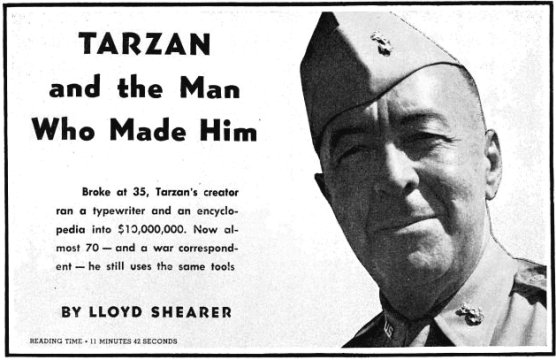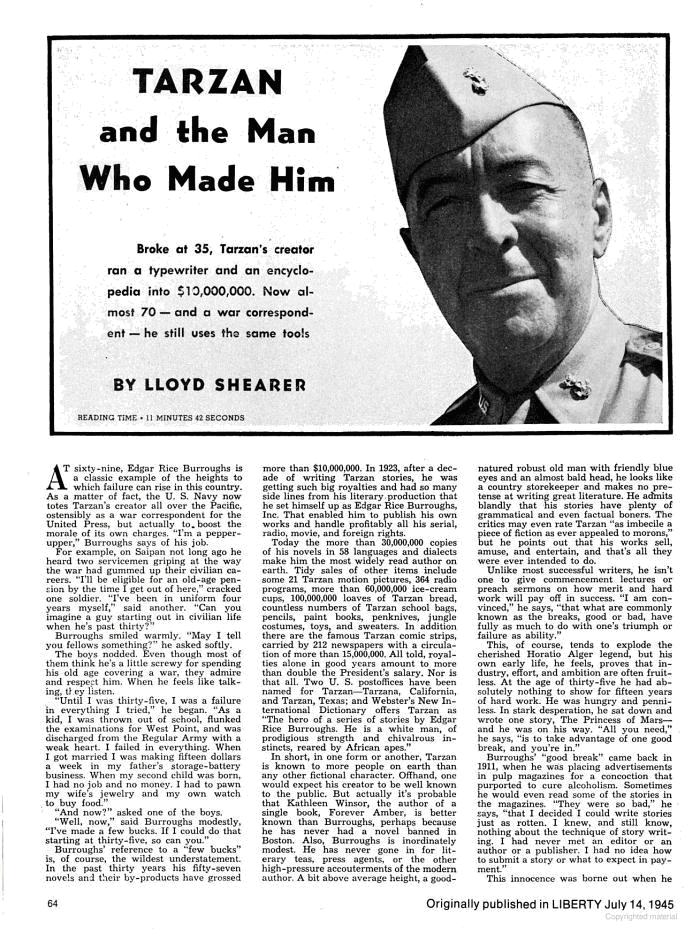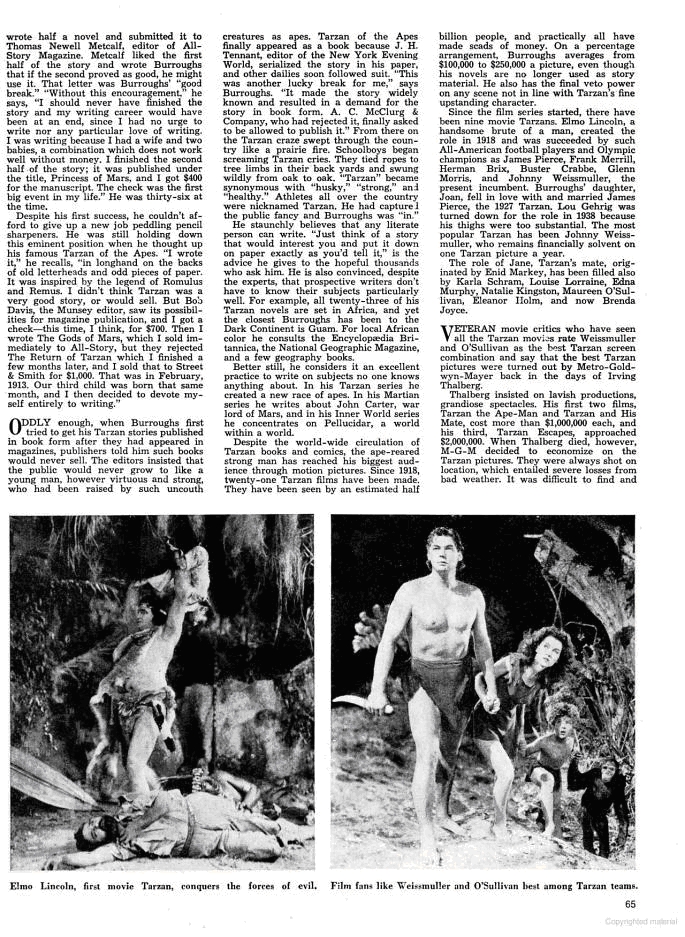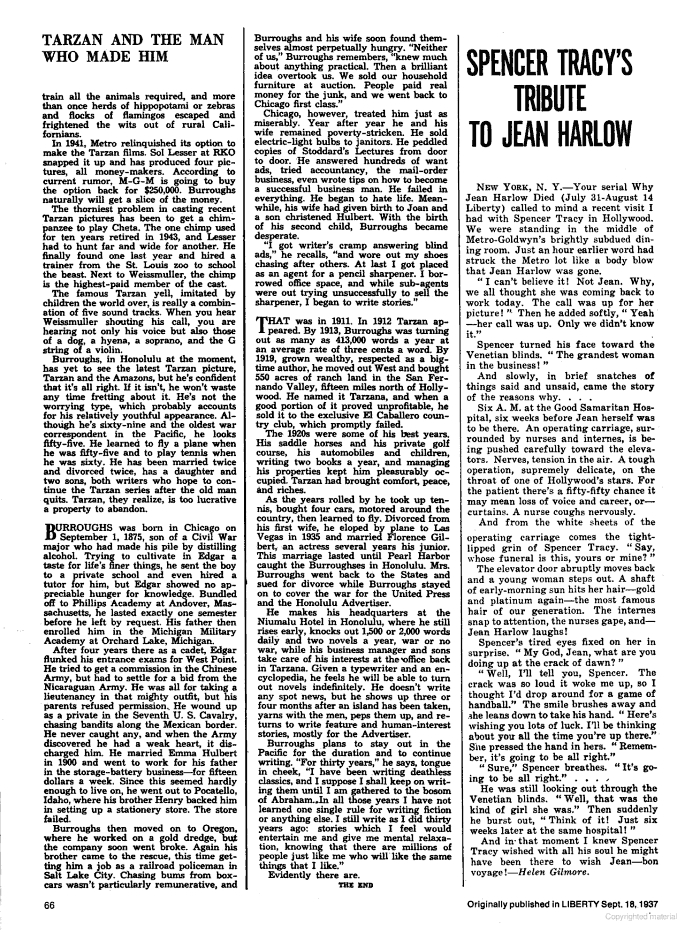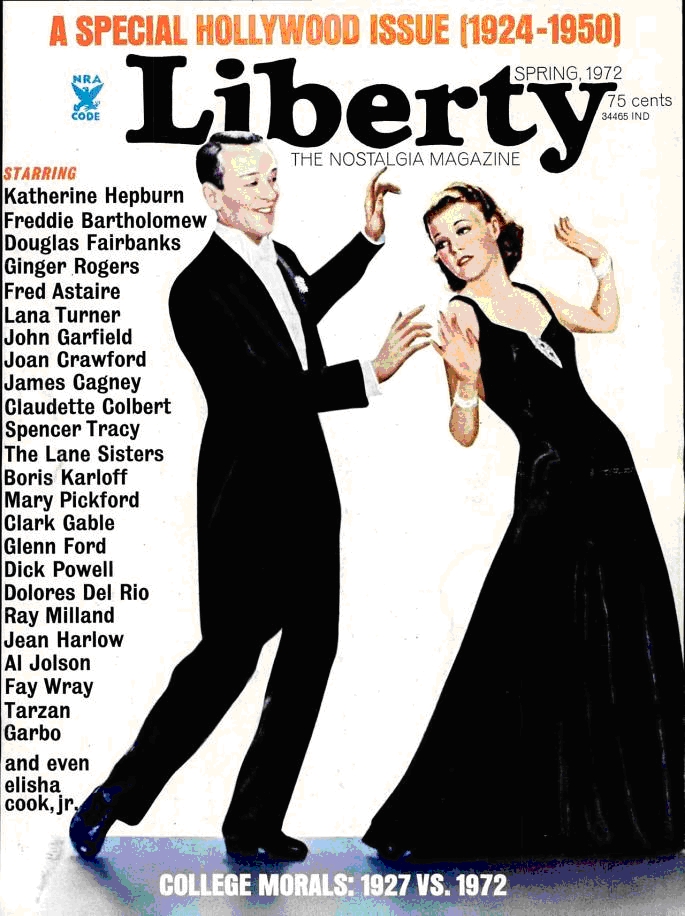At sixty-nine, Edgar Rice Burroughs is a classic
example of the heights to which failure can rise in this country. As a
matter of fact, the U.S. Navy now totes Tarzan's creator all over the Pacific,
ostensibly as a war correspondent for the united Press, but actually to
boos the morale of its own charges. "I'm a pepper upper," Burroughs says
of his job.
For example, on Saipan not long ago he heard two servicemen
griping at the way the war had gummed up their civilian careers. "I'll
be eligible for an old-age pension by the time I get out of here, "cracked
one soldier. "I've been in uniform four years myself, said another. "Can
you imagine a guy starting out in civilian life when he's past thirty?"
Burroughs smiled warmly. "May I tell you fellows something?"
he asked softly.
The boys nodded. even though most of them think he's a
little screwy for spending his old age covering a war, they admire and
respect him. When he feels like talking, they listen.
"Until I was thirty-five, I was a failure in everything
I tried," he began. "As a kid, I was thrown out of school, flunked the
examinations for West point, and was discharged from the Regular Army with
a weak heart. I failed in everything. When I got married I was making fifteen
dollars a week in my father's storage-battery business. When my second
child was born, I had no job and no money. I had to pawn my wife's jewelry
and my own watch to buy food."
"And now?" asked one of the boys.
"Well, now," said Burroughs modestly, "I've made a few
bucks. If I could do that starting at thirty-five, so can you."
Burroughs' reference to a "few bucks" is, of course, the
wildest understatement. In the past thirty years his fifty-seven novels
and their by-products have grossed more than $l0,000,000. IN 1923, after
a decade of writing Tarzan stories, he was getting such big royalties and
had so many side lines from his literary production that he set himself
up as Edgar Rice Burroughs, Inc. That enabled him to publish his own works
and handle profitably all his serial, radio, movie, and foreign rights.
Today the more than 30,000, 000 copies of his novels in
58 languages and dialects make him the most widely read author on earth.
Tidy sales of other items include some 21 Tarzan motion pictures, 364 radio
programs, more than 60,000,000 ice-cream cups, 100,000,000 loaves of Tarzan
bread, countless numbers of Tarzan school bags, pencils, paint books, penknives,
jungle costume, toys, and sweaters. In addition there are the famous Tarzan
comic strips, carried by 212 newspapers with a circulation of more than
15,000,000. All told, royalties alone in good years amount to more than
double the President's salary. Nor is that all. Two U. S. post offices
have been named for Tarzan -- Tarzana, California, and Tarzan, Texas; and
Webster's New International Dictionary offers Tarzan as "The hero of a
series of stories by Edgar Rice Burroughs. He is a white man, of prodigious
strength and chivalrous instincts, reared by African apes."
In short, in one form or another, Tarzan is known to more
people on earth than any other fictional character. Offhand, one would
expect his creator to be well known to the public. But actually it's probable
that Kathleen Winsor, the author of a single book, Forever Amber, is better
known than Burroughs, perhaps because he has never had a novel banned in
Boston. Also, Burroughs is inordinately modest. He has never gone in for
literary teas, press agents, or the other high-pressure accouterments of
the modern author. A bit above average height, a good-natured robust old
man with friendly blue eyes and an almost bald head, he looks like a country
storekeeper and makes no pretense at writing great literature. He admits
blandly that his stories have plenty of grammatical and even factual boners.
The critics may even rate Tarzan "as imbecile a piece of fiction as ever
appealed to morons," but he points out that his works sell, amuse, and
entertain, and that's all they were ever intended to do.
Unlike most successful writers, he isn't one to give commencement
lectures or preach sermons on how merit and hard work will pay off in success.
"I am convinced," he says, "that what are commonly known as the breaks,
good or bad, have fully as much to do with one's triumph or failure as
ability."
This, of course, tends to explode the cherished Horatio
Alger legend, but his own early life, he feels, proves that industry, effort,
and ambition are often fruitless. At the age of thirty-five he had absolutely
nothing to show for fifteen years of hard work. He was hungry and penniless.
In stark desperation, he sat down and wrote one story, The Princess of
Mars -- and he was on his way. "All you need," he says, "is to take advantage
of one good break, and you're in."
Burroughs' "good break" came back in 1911, when he was
placing advertisements in pulp magazines for a concoction that purported
to cure alcoholism. Sometimes he would even read some of the stories in
the magazines. "They were so bad," he says, "that I decided I could write
stories just as rotten. I knew, and still know, nothing about the technique
of story writing. I had never met an editor or an author or a publisher.
I had no idea how to submit a story or what to expect in payment."
This innocence was borne out when he wrote half a novel
and submitted it to Thomas Newell Metcalf, editor All-Story Magazine. Metcalf
liked the first half o f the estuary and wrote Burroughs that if
the second proved as good, he might use it. That letter was Burroughs'
"good break." "Without this encouragement," he says, "I should never have
finished the story and my writing career would have been at an end, since
I had no urge to write nor any particular love of writing. I was writing
because I had a wife and two babies, a combination which does not work
well without money. I finished the second half of the story; it was published
under the title, Princess of Mars, and I got $400 for the manuscript. The
check was the first big event in my life." He was thirty-six at the time.
Despite his first success, he couldn't afford to give
up a new job peddling pencil sharpeners. He was still holding down this
eminent position when he thought up hs famous Tarzan of the Apes. "I wrote
it," he recalls, "in longhand on the backs of old letterheads and odd pieces
of paper. It was inspired by the legend of Roomfuls and Remus. I didn't
think Tarzan was a very good story, or would sell. But Bob Davis, the Munsey
editor, saw its possibilities of magazine publication, and I got a check
-- this time, I think, for $700. Then I wrote The Gods of Mars, which I
sold immediately to All-Story, but they rejected The Return of Tarzan which
I finished few months later, and I sold that to Street and Smith
for $1,000. That was in February, 1913. Our third child was born that same
month, and I then decided to devote myself entirely to writing."
Oddly enough, when Burroughs first tired to get his Tarzan
stories published in book form after they had appeared in magazines, publishers
told him such books would never sell. The editors insisted that the public
would never grow to like a young man, however virtuous and strong, who
had been raised by such uncouth creatures as apes. Tarzan of the Apes finally
appeared as a book because J. H. Tennant, editor of the New York Evening
World, serialized the story in his paper, and other dailies soon followed
suit. "This was another lucky break for me," says Burroughs. "It made the
story widely known and resulted in a demand for r the story in book form.
A. C. McClurg & Company, who had rejected it, finally asked to be allowed
to publish it." From there on the Tarzan craze swept through the country
like a prairie fire. Schoolboys began screaming Tarzan cries. They tied
ropes to tree limbs in their back yards and swung wildly from oak to oak.
"Tarzan" became synonymous with "husky," "strong," and "healthy." Athletes
all over the country were nicknamed Tarzan. He had captured the public
fancy and Burroughs was "in."
He staunchly believes that any literate person can write.
"Just think of a story that would interest you and put it down on paper
exactly as you'd tell it," is the advice he gives to the hopeful thousands
who ask him. He is also convinced, despite the experts, that prospective
writers don't have to know their subjects particularly well. For example,
all twenty-three of his Tarzan novels are set in Africa, and yet the closest
Burroughs has been to the Dark Continent is Guam. For local African color
he consults the Encyclopedia Britannica, the National Geographic Magazine,
and a few geography books.
Better still, he considers it an excellent practice to
write on subjects no one knows anything about. In his Tarzan series he
created a new race of apes. In his Martian series he writes about John
Carter, warlord of Mars, and in his Inner World series he concentrates
on Pellucidar, a world within a world.
Despite the word-wide circulation of Tarzan books and
comics, the appeared strong man has reached his biggest audience through
motion pictures. Since 1918, twenty-one Tarzan films have been made. They
have been seen by an estimated half billion people, and practically
all have made scads of money. On a percentage arrangement, Burroughs averages
from $100,000 to $250,000 a picture even though his novels are no longer
used as story material. He also has the final veto power on any scene not
in line with Tarzan's fine upstanding characters.
Since the film series started, there have been nine movie
Tarzans. Elmo Lincoln, a handsome brute of a man, created the role in 1918
and was succeeded by such All-American football players and Olympic champions
as James Pierce, frank Merrill, Herman Brix, Buster Crabbe, Glenn Morris,
and Johnny Weissmuller, the present incumbent. Burroughs' daughter Joan,
fell in love with and married James, Pierce, the 1927 Tarzan. Lou Gehrig
was turned down for the role in 1938 because his thighs were too substantial.
The most popular Tarzan has been Johnny Weissmuller, who remains financially
solvent on one Tarzan picture a year.
The role of Jane, Tarzan's mate, originated by Enid Markey,
has been filled also by Karla Schram, Louise Lorraine, Edna Murphy, Natalie
Kingston, Maureen O'Sullivan, Eleanor Holm, and now Brenda Joyce.
Veteran movie critics who have seen all the Tarzan movies
rate Weissmuller and O'Sullivan as the best Tarzan screen combination and
say that the best Tarzan pictures were turned out by Metro-Goldwyn-Mayer
back in the days of Irving Thalberg.
Thalberg insisted on lavish productions, grandiose spectacles.
His first two films, Tarzan the Ape-Man and Tarzan and His Mate, cost more
than $1,000,000 each, and his third, Tarzan Escapes, approached $2,000,000.
When Thalberg died, however, M-G-M decided to economize on the Tarzan pictures.
They were always shot on location, which entailed severe losses from bad
weather. It was difficult to find and train all the animals required, and
more than once herds of hippopotami or zebras and flocks of flamingos escaped
and frightened the wits out of rural Californians.
In 1941, Metro relinquished its option to make the Tarzan
films. Sol Lesser at RKO snapped it up and has produced four pictures,
all money-makers. According to current rumor, M-G-M- is going to buy the
option back for $250,000. Burroughs naturally will get a slice of the money.
The thorniest problem in casting recent Tarzan pictures
has been to get a chimpanzee to play Cheta. The one chimp used for ten
years retired in 1943, and Lesser had to hun far and wide for another.
He finally found one last year and hired a trainer from the St. Louis zoo
to school the beast. Next to Weissmuller, the chimp is the highest-paid
member of the cast.
The famous Tarzan yell, imitated by children the world
over, is really a combination of five sound tracks. When you hear Weissmuller
shouting his call, you are hearing not only his voice but also those of
a dog, a hyena, a soprano, and the G string of a violin.
Burroughs, in Honolulu at the moment has yet to see the
latest Tarzan picture, Tarzan and the Amazons, but he's confident that
it's all right. If it isn't, he won't waste any time fretting about it.
He's not the worrying type, which probably accounts for his relatively
youthful appearance. Although he's sixty-nine and the oldest war correspondent
in the Pacific, he looks fifty-five. He learned to fly a plane when he
was fifty-five and to play tennis when he was sixty. He has been married
twice and divorced twice, has a daughter and two sons, both writers who
hope to continue the Tarzan series after the old man quits. Tarzan, they
realize, is too lucrative a property to abandon.
Burroughs was born in Chicago on September 1, 1875, son
of a Civil War major who had made his pile by distilling alcohol. Trying
to cultivate in Edgar a taste for life's finer things, he sent the boy
to a private school and even hired a tutor for him, but Edgar showed no
appreciable hunger for knowledge. Bundled off to Phillips Academy at Andover,
Massachusetts, he lasted exactly one semester before he left by request.
HIs father then enrolled him in the Michigan Military Academy at Orchard
Lake, Michigan.
After four years there as a cadet, Edgar flunked his entrance
exams for West Point. He tried to get a commission int he Chinese Army,
but had to settle for a bid from the Nicaraguan Army. He was all for taking
a lieutenancy in that mighty outfit, but his parents refused permission.
He wound up as a private in the Seventh U. S. Cavalry, chasing bandits
along the Mexican border. He never caught any, and when the Army discovered
he h ad a weak heart, it discharged him He married Me Hulbert in 1900 and
went to work for his father in the storage-battery business -- for fifteen
dollars a week. Since this seemed hardly enough to live on, he went out
to Pocatello, Idaho, where his brother Henry backed him in setting up a
stationery store. The store failed.
Burroughs then moved on to Oregon, where he worked on
a gold dredge, but the company soon went broke. Again his brother came
to the rescue, this time getting him a job as a railroad policeman in Salt
Lake City. Chasing bums from boxcars wasn't' particularly remunerative,
and Burroughs and his wife soon found themselves almost perpetually hungry.
"Neither of us," Burroughs remembers, "Knew much about anything practical.
Then a brilliant idea overtook us. We sold our household furniture at an
auction. People paid real money for junk, and we went back to Chicago first
class.
Chicago, however, treated him just as miserably. Year
after year he and his wife remained poverty-stricken. He sold electric-light
bulbs to janitors. He peddled copies of Stoddard's Lectures from door to
door. He answered hundreds of want ads, tried accountancy, the mail-order
business, even wrote tips on how to become a successful business man. He
failed in everything. He began to hate life. Meanwhile, his wife had given
birth to Joan and a son christened Hulbert. With the birth of his second
son, Burroughs became desperate.
"I got writer's cramp answering blind ads," he recalls
, "and wore out my shoes chasing after others. At last I got placed as
an agent for a pencil sharpener. I borrowed office space, and while sub-agents
were out trying unsuccessfully to sell the sharpener. I began to write
stories."
That was in 1911. IN 1912 Tarzan appeared. By 1913, Burroughs
was turning out as many as 413,000 words a year at an average rate of three
cents a word. by 1919, grown wealthy, respected as a big-time author, he
moved out West and bought 550 acres of ranch land in the San Fernando Valley,
fifteen miles north of Hollywood. He named it Tarzana, and when a good
portion of it proved unprofitable, he sold it to the exclusive Caballero
country club, which promptly failed.
The 1920s were some of his best years. His saddle horses
and his private golf course, his automobiles and children writing two books
a year, and managing his properties kept him pleasurably occupied. Tarzan
had brought comfort, peace, and riches.
As the years rolled by he took up tennis, bought four
cars, motored around the country, then learned to fly. Divorced from his
first wife, he eloped by plane to Las Vegas in 1935 and married Florence
Gilbert, an actress several years his junior. This marriage lasted until
Pearl Harbor caught the Burroughses in Honolulu. Mrs. Burroughs went back
to the States and sued for divorce while Burroughs stayed on to cover the
war for the United Press and the Honolulu Advertiser.
He makes his headquarters at the Niumalu Hotel in Honolulu,
where he still rises early, knocks out 1,500 or 2,000 words daily and two
novels a year, war or no war, while his business manager and sons take
care of his interests at the office back in Tarzana. Given a typewriter
and an encyclopedia, he feels he will be able to turn out novels indefinitely.
He doesn't write any spot news, but he shows up three or four months after
the island has been taken, yarns with the men, peps them up, and returns
to write feature and human-interest stories, mostly for the Advertiser.
Burroughs plans to stay out in the Pacific for the duration
and to continue writing. "For thirty years," he says, tongue in cheek,
"I have been writing deathless classics, and I suppose I shall keep on
writing them until I am gathered to the bosom of Abraham. In all those
years I have not learned one single rule for writing fiction or anything
else. I still write as I did thirty years ago; stories which I feel would
entertain me and give me mental relaxation, knowing that there are millions
of people just like me who will like the same things that I like."
Evidently there are.
THE END

